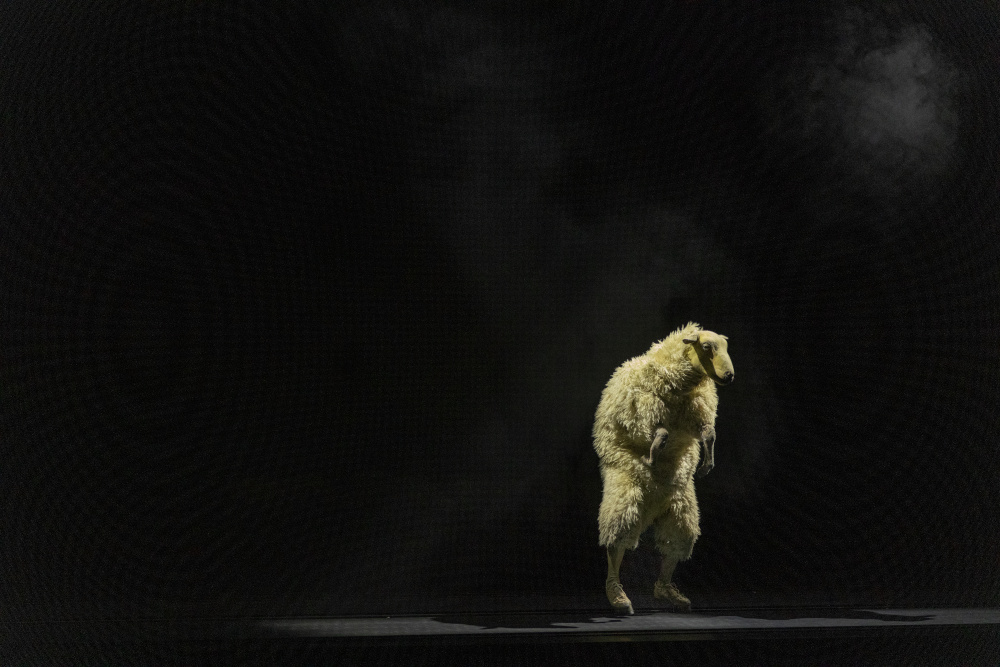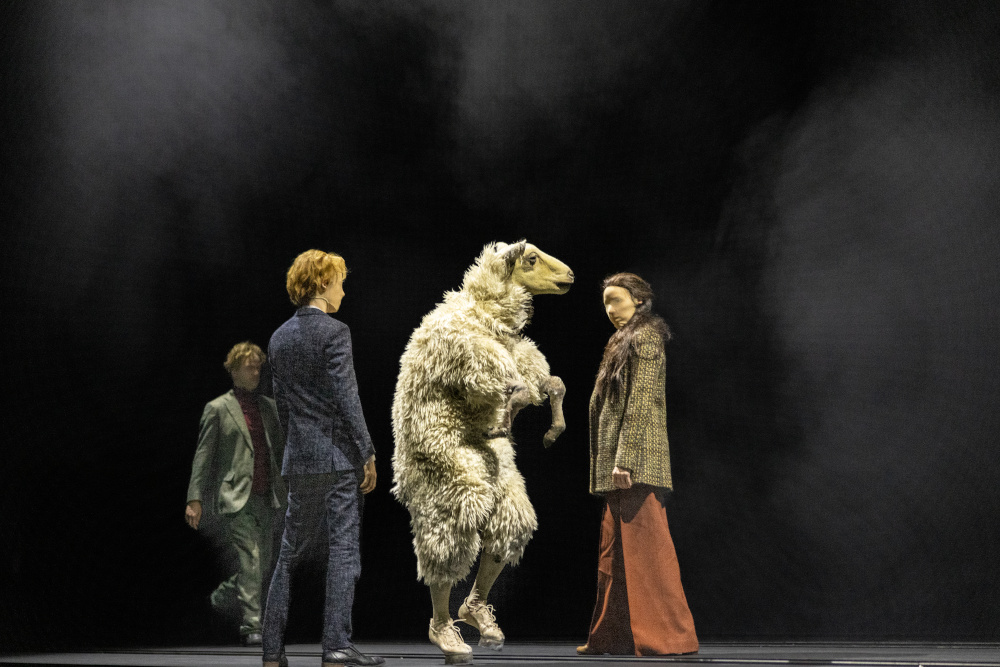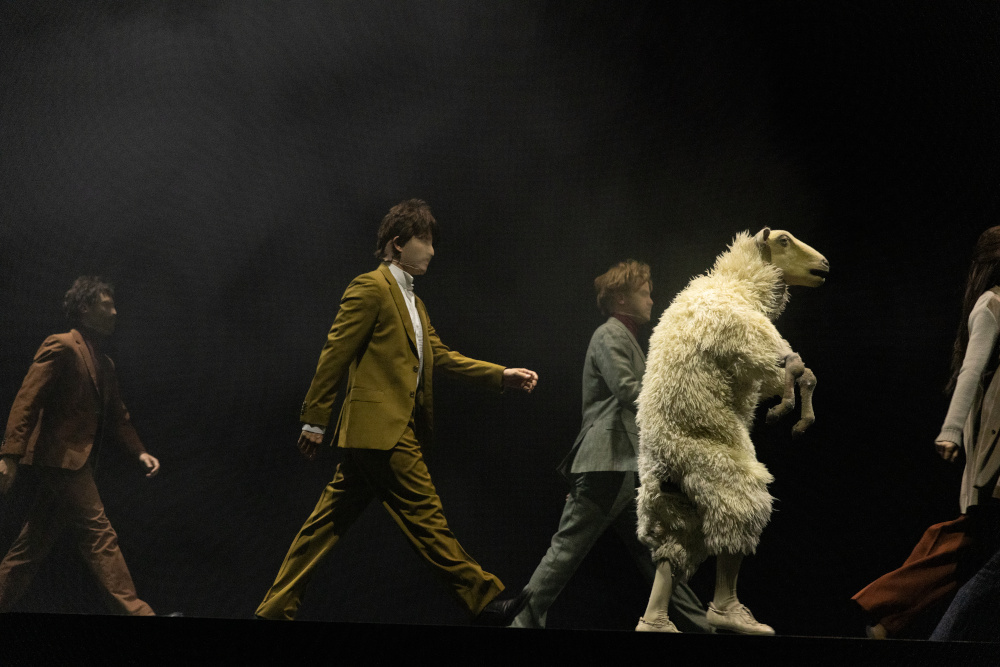Adelaide Festival
The Sheep Song
by Jonas Vermeulen, Stef Aerts, Joe Agemans, Thomas Verstraeten, Marie Vinck, Matteo Simoni with Bart Hollanders, Titus De Voogdt, Yorrith De Bakker.
FC Bergman
Toneelhuis, Antwerp.
Dunstan Playhouse, Adelaide Festival Centre
March 16. Until March 19.

Titus De Voogdt
In the final weekend of the Adelaide Festival’s theatre program comes the most intriguing- the FC Bergman company’s The Sheep Song. Described in their program notes as “a visual story without words, an epic solely for the eye. It is explicitly in keeping with the tradition of the animal fable, but also a variation on it.”
This sometimes mystifying, often compelling, always fascinating 75 minutes of theatre begins with the tolling of a huge bell suspended from the proscenium. Our attention is drawn to a scratching, restless sound of hooves and gradually, through dim lighting, we see a flock of sheep. Ten actual living, breathing sheep. Their movement is aimless and silent – not a bleat to be heard. It is eerie, and more so, when a single figure is visible, writhing and struggling as if in some distress. Gradually we watch as this one sheep manages to stand, tottering on its hind legs.
Speaking of fables, a modern one comes to mind – George Orwell’s Animal Farm. Is this sheep declaring “Two legs good, four legs bad”? Certainly they (the non-specific pronoun is apt here) are standing out by standing up, moving away from the flock as it meanders back into the backstage wings.

From there the epic journey of Ovis Orientalis Avis begins. A wild sheep in flight indeed. Except that our woolly quester is marching with a spring in their hooves. Moving on the perpetual conveyor belts on the stage floor Ovis O is surrounded by other people – commuters, workers – all intent on destinations, paying no heed to each other but glancing with momentary hostility at the outsider making conspicuous efforts to fit in with their new adopted herd.
Lit by Ken Hioco like a surreal Flemish painting in russet and dark tones and enveloped by Senjan Janssen’s sound design and Frederik Leroux-Roels’s ambient music, augmented by pensive banjo played live onstage, the production has a sense of curiosity and wonder counterpointed by apprehension, anxiety and sudden violence.
The Sheep encounters random other travellers in the world as they move relentlessly, and seemingly without purpose, back and forth across the stage. Much of the view is in profile. A blind woman with a cane has (another real) barking dog on a lead. The Sheep pauses to watch a ranting speaker, presented as a miniature puppet booth with red curtains. We have no idea what is being said but this bitter orator (who is constantly resorting to ribald priapic exhibitionism) is definitely not offering a message of peace and hope.
Our hero is intercepted a number of times by a kind of herald figure, naked from the waist down and whose head is completely swathed in a red scarf. With his puckish gyrations and portentous implications this device is one of the few jarring elements in an otherwise splendidly judged production.
In another cameo the Sheep encounters a matador carrying a bull’s head, which in turn the bullfighter wears himself and lays back in the Sheep’s embrace as he dies from his wounds. It is unaccountably poignant tableau, like a pieta between sheep and bull. And a grim reminder that meat is murder.

Most disturbing is the episode with the crying infant -part sheep, part human- which the Sheep tries to soothe without success. It is a deeply disturbing shift in the narrative. As is the gradual shedding of the sheep characteristics. Having hands to play the banjo and now wearing a jacket is a poor exchange for what we come to realise is the Sheep’s intrinsic nobility.
Throughout the performance our eyes are fastened on the Sheep. This is due in no small part to the superb costume designed by Joelle Meerbergen and the extraordinary performance by Titus De Voogdt. He finds gestures, feelings and melancholy puzzlement to memorably capture the experience of the Other in a hostile, self-preoccupied, emotionally insecure world. This Sheep’s song is a sad one and the world he has taken up will never be his. Neither, as he returns without his golden fleece and gentle nobility, will the paddock from where he first set forth.
Copyright. murraybramwell.com

I was so impressed by the skill involved in this production on every level, but I also found it deeply disturbing in ways that I cannot begin to articulate. I agree with all you said, including the incredible costume, the work involved in the use of the conveyor belt (the field of flowers for example. How was that managed? Awesome!), the aura created by the sound of the hooves before we saw the sheep, and the calm almost focused movement of the flock itself. Several seemed almost NIDA trained!
This and other things in this year’s program are examples of what festivals exist for, in my opinion.
Thank you for such an interesting comprehensive commentary.
Comment by Kathy — March 20, 2023 @ 10:07 pm